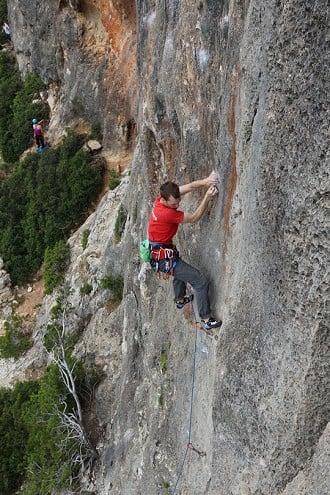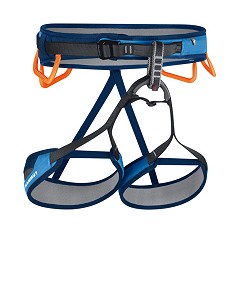

A harness has to do two things; allow you to carry a rack of kit up your chosen route, and hold your weight when you fall off. But as you are going to be using this bit of kit quite a lot, you may as well get something that does the job well.
For British climbers, this tends to mean deciding what you want most out of your harness and what you will be using it for the most too. Are you only really interested in trad-climbing? Prefer clipping bolts? Maybe you only really get keen at the thought of ice and mixed climbing in Scotland? Maybe you like to do it all?
Is the Mammut Ophir Harness for you?
The basic features of the Ophir harness aim it towards all-round summer rock-climbers and indoor climbing; it has fixed leg-loops, no ice-screw clipper attachments and four medium-sized gear loops, this is not a specialist harness.
For me the most important aspects of a harness are; how comfortable it is to hang in for hours whilst multi-pitch trad climbing, how well it carries a full trad rack, and finally how durable it is. With the harness arriving just after I got back from Spain, it was soon time to hit the trad-crags. With a friend's stag do in Pembroke on the cards, I utilised the opportunity to be both grouchy and easily confused to put the Ophir through it's paces.
After a long drive and a heavy night of drinking and stagging until the early morning, we all congregated, munching on fried breakfasts and thanking the rain for falling and preventing immediate departure. Soon enough though, the rain cleared and we were out on the crags. Heading straight to Mewsford on an incoming tide my partners and I just made it to the start of Daydreams a three pitch E2, which whilst being an obvious choice as an 'Extreme Rock' tick, it was also the first trad we had done in a while. The route was wet and greasy and I was hungover and had forgotten to bring any food to the crag.
Setting off on the second pitch with my rack swinging around my waist and my head swimming, I fortunately found the gear loops worked really well, enabling to spread my rack out and with it all easy to access. I arrived at where I thought the belay should be and sat back into my harness, wondering exactly how long it was until I could get to the St. Govan's Inn. After a little while my seconds arrived at the belay, and we slowly sorted rack and ropes ready for the next leader to lead off. To my surprise it was only once I was almost ready to set off climbing that I noticed a slight discomfort from hanging in my harness.
I have used the harness regularly since this first outing, for both trad and sport climbing, and am very impressed with its comfort and usability. It's also in some snazzy colours and has a plastic protector to increase durability in the point at which the leg loops are connected to the belay loop, which I have always found to be the first bit of a harness to wear out. My only criticism is that the front gear loops slope forward, which as I have to wear the harness as tight as possible, means that on slabbier routes my rack often gets in my line of view or gets caught on the rock. This isn't a major issue, but was something I occasionally found annoying.
Conclusion
All in all this is a great all-round harness for UK rock-climbers which is durable, comfortable, light and good at carrying a trad rack. If you have to cinch the harness up tight and enjoy slabby routes, it may be worth clipping a load of rack to the harness and checking you don't find it bunches up too much for you at the front. In addition to this, it is great value for money and is one of the cheaper harnesses on the market.

Mammut Ophir Harness
The second generation of the sporty Ophir harness is based on the innovative Mammut® two-part webbing technology and offers maximum comfort, excellent breathability and a huge range of movement. The fresh, asymmetrical design is a real eye-catcher on the rocks and in the climbing gym.
Features:
- Special two-part webbing construction ensures maximum comfort.
- New and exclusive Mammut® Slide Bloc buckles.
- Patented tie-in protector prevents the harness from abrasion damage.
- 4 gear loops.
- 4 gear loops.
- 380g
Price: £50.00
MORE INFO: Mammut Website











Comments